By
The bandoneon, name, origin and manufacturers

n early classification of musical instrument established three categories: 1) stringed instruments, 2) wind instruments and 3) percussion. The bandoneon, correctly, was included among wind instruments. But this classification was abandoned because there was not a unity of criteria, since 1 and 2 took into consideration what vibrated and 3, what originated the vibration.
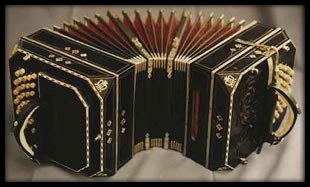 In 1914 the musicologists Eric von Hombostel and Curt Sachs established a definitive classification based on the question: What does vibrate?: 1) the material that composes the instrument vibrates due to its rigidity (xylophone or marimba, among others), 2) membranes rigidly stretched that vibrate (tambourine, etc.), 3) the vibration of one or several taut strings fixed at both ends (guitar, violin, etc.) 4) or the air itself is driven into vibration, like in pipe organs, harmoniums, which are called wind instruments, and here comes the bandoneon along with the ones which preceded it like the accordion or, more directly, the concertina.
In 1914 the musicologists Eric von Hombostel and Curt Sachs established a definitive classification based on the question: What does vibrate?: 1) the material that composes the instrument vibrates due to its rigidity (xylophone or marimba, among others), 2) membranes rigidly stretched that vibrate (tambourine, etc.), 3) the vibration of one or several taut strings fixed at both ends (guitar, violin, etc.) 4) or the air itself is driven into vibration, like in pipe organs, harmoniums, which are called wind instruments, and here comes the bandoneon along with the ones which preceded it like the accordion or, more directly, the concertina.
Then it can be defined as a portable reed instrument with keys (buttons), driven by a bellows, played with both hands simultaneously in which the pressure of the air is forced through a system of free metallic reeds. On the right side you have the treble sounds and on the left, the bass notes, an octave lower.
There are chromatic bandoneons that produce the same notes opening or closing the bellows. Even though the latter appeared in the experimental stage it was still used in Europe and even in Japan until the Argentine players arrived. And the non-chromatic, with wider possibilities, the one used by the professional tango musicians, which varies its expression depending on whether it is played opening or closing, producing dissonances and assonances. The latter are also called diatonic or bi-sonorous instruments.
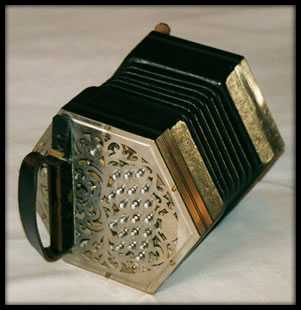 Of German origin, what is most widely accepted is that its name derives from one of its probable creators or, at least, its principal advertiser: Heinrich Band. And as for the suffix that follows the name there are different opinions although the one that prevails states that a sort of cooperative was formed to raise funds for the construction of the instrument, thus originating the term band-union, changed for euphonic reasons into bandonion. For other researchers, it seems possible that bandonion had taken the suffix onion from several antecessors like the Aeolodikon, the Aeolomodikon, the Elodikon or the akkordion(accordion) itself. All them based on the same principle of a reed that vibrates.
Of German origin, what is most widely accepted is that its name derives from one of its probable creators or, at least, its principal advertiser: Heinrich Band. And as for the suffix that follows the name there are different opinions although the one that prevails states that a sort of cooperative was formed to raise funds for the construction of the instrument, thus originating the term band-union, changed for euphonic reasons into bandonion. For other researchers, it seems possible that bandonion had taken the suffix onion from several antecessors like the Aeolodikon, the Aeolomodikon, the Elodikon or the akkordion(accordion) itself. All them based on the same principle of a reed that vibrates.
Instead, to regard it as an offshoot of the harmonium would be mistaken. The latter instrument has nothing to do with the bandoneon, save that is driven by a bellows and has a certain similarity of sound.
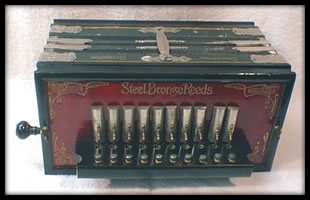 In our country we probably came to the term bandoneon when it was exported to South American countries, it had to be written like that. In Argentina it had several derivations either oral or written such as mandoleón, mandolión, bandoleón, bandolión, possibly due to uneducated people’s mistakes or the language used by the players themselves. The latter were qualified for music but had scarce school instruction.
In our country we probably came to the term bandoneon when it was exported to South American countries, it had to be written like that. In Argentina it had several derivations either oral or written such as mandoleón, mandolión, bandoleón, bandolión, possibly due to uneducated people’s mistakes or the language used by the players themselves. The latter were qualified for music but had scarce school instruction.
Heinrich Band was born in the city of Krefeld, Germany. Music teacher and luthier, one of the 16 siblings of Peter Band, he was as well musician and merchant of musical instruments. He was staff cellist in an orchestra in his town and around 1840 he had known the concertina —created by Carl Friedrich Ufflig— an instrument that can be considered the immediate antecessor of the bandoneon and he included it in the aggregation in which he played. That instrument attracted his interest but because of the limited range it had he wanted to improve it. In 1843 he opened a shop of musical instruments. There around 1846 he might have devised the bandoneon.
The early instruments made by Band had 56 tones with 14 bi-sonorous keys on each side. Later he manufactured another with 64 tones and other with 88. Roth thinks that, basically, the bandoneon is but an improved concertina, with a different layout of the button-boards and, above all, with a different sound. Maybe because of that it was never patented.
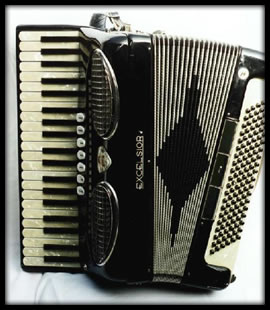 The 64-tone bandoneon had 32 keys, 17 on the right side and 15 on the opposite side, and each key played a different note. The one with 88 tones had 44 keys, 23 on the right side (treble notes) and 21 on the left (bass notes).
The 64-tone bandoneon had 32 keys, 17 on the right side and 15 on the opposite side, and each key played a different note. The one with 88 tones had 44 keys, 23 on the right side (treble notes) and 21 on the left (bass notes).
Heinrich, contributed furthermore to the diffusion of the instrument with several transcriptions of piano works adapted for bandoneon. He composed some waltzes and polkas. After he died the shop was run by his wife, firstly with a partner and lately with her eldest son Alfred. They published Scales and chords in all the major and minor tonalities for bandoneon, which was one of the first books of studies released for the instrument.
In 1986 the researcher Manuel Román added his point of view to this issue stating that Band had not created it but Carl Zimermann had made it instead. He is based on an advertisement published by Band in 1850 which says: «To accordion lovers: about a new invention, once again we have notably improved our accordions, and these newly made, of round or octagonal shape with 88 or 104 tones are available in our shop». From this ad this researcher took these arguments to back his hypothesis: 1) that in it the word bandoneon does not appear; 2) that Band does not say that he is the inventor of it. And he adds that in the city of Krefeld there is no record of the above-mentioned Band-union cooperative, furthermore Band was registered as merchant and was not a manufacturer. There is no evidence that he had employees in his shop that could have helped him in its construction. Finally that Zimermann based his creation on the Ufflig's German concertina and he called it Carlsfelder Konzertina. The invention would date back to a short time before 1849, because that year he presented the instrument he manufactured at the Industrial Exposition of Paris». Finally Román says that Zimermann sold his factory to Ernest Louis Arnold and went to North America.
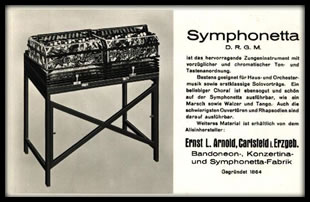 Both versions has the same origin, Uhlig's concertina. It is also quite possible that both built it with a series of technical differences, such as the number of keys, the diversity of models, the number of notes at the right and left boards, etc.
Both versions has the same origin, Uhlig's concertina. It is also quite possible that both built it with a series of technical differences, such as the number of keys, the diversity of models, the number of notes at the right and left boards, etc.
Since the early days of its release it has been a patrimony almost exclusive of Germany whose manufacturers carefully did their best to hide certain secrets, especially everything concerning the metallic alloys used in the reed manufacturing.
Ernest Louis Arnold (1828-1910) was the manufacturer of the ELA bandoneons which were imported in Argentina and sold by Alberto Ohermann. Thereafter the direction of the firm was taken by his children until the youngest, Alfred (1878-1933), who with all the experience he achieved since his early years, in 1911 founded the firm Alfred Arnold Bandonion, which manufactured the famous and highly praised AA (Double A). In later advertisements it was announced as follows: «The only instrument for a perfect interpretation of Argentine tango».
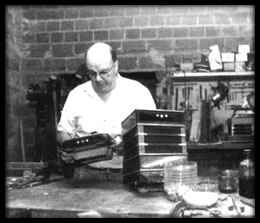 The factory offered three models: plain, with half inlay of mother-of-pearl and with full mother-of-pearl inlaid work. After the First World War they were imported by the Emilio Pitzer house, which had a registered mark, and by Luis Mariani.
The factory offered three models: plain, with half inlay of mother-of-pearl and with full mother-of-pearl inlaid work. After the First World War they were imported by the Emilio Pitzer house, which had a registered mark, and by Luis Mariani.
Bandoneons also arrived under the false denomination America for the music store of that name until that trick was discovered. Arnold as well manufactured the Premier instruments, of an excellent quality, which were imported by Sharp and Veltren. Another renowned trademark was Germania, constructed by M:Hohner A:G (Mathis Hohner). These instruments were quite solid and of an excellent finish. The same house released the brands Tango, Cardenal (in its country was Cardinal) and also Concertista, all them imported by Oherman.
The brothers Alfred and Paul Arnold were succeeded by their respective sons. One of them, Horst Alfred, wrote to the writer of this work: «Maybe you know that the enterprise is no longer existent, my factory was expropriated and is, since 1949 people's factory. Now they manufacture pumps for diesel engines. In 1950 I went to Frankfurt and since then I devote myself to selling and tuning bandonios (sic) in good state».
Paul Arnold's son, Alfred's brother and partner, managed to flee from East Germany and, in the western zone of the then divided country, established his own factory in the city of Obertshausen. Alfred's former technician, Mr. Muller, was his assistant. The firm closed soon after his owner died in 1971. Now there are no factories for the production of bandoneons.
The experts estimate that this instrument may have a useful life of 200 years. In this somber panorama a light of hope has the name of another German who is not fifty years old yet. His name is Klaus Gutjahr. He builds them in a handicraft style and to order. The model Gutjahr II was made taking into account the needs of the tango players in the River Plate, without disregarding its suitability to the interpretation of sacred and concerto music.
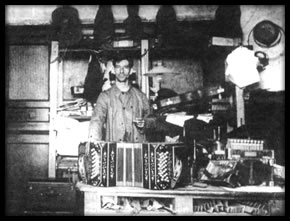 In our milieu Emilio Torija made an early attempt to manufacture them as a handicrafter and he would be then the first manufacturer in our country. He also run a tuning workshop on 3961 Rivadavia Avenue.
In our milieu Emilio Torija made an early attempt to manufacture them as a handicrafter and he would be then the first manufacturer in our country. He also run a tuning workshop on 3961 Rivadavia Avenue.
At a cabaret where the Pedro Polito's orchestra played, on a poster was announced: «Bandoneon manufactured by an Argentinian». Presently in the city of Bahía Blanca there is a bandoneon luthier born in 1920, who owns a small workshop where, on order, he manufactures bandoneons, including their matrices.
From the book El tango, el bandoneón y sus intérpretes, Oscar Zucchi, Ed. Corregidor, 1998.